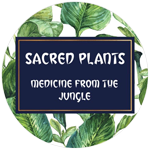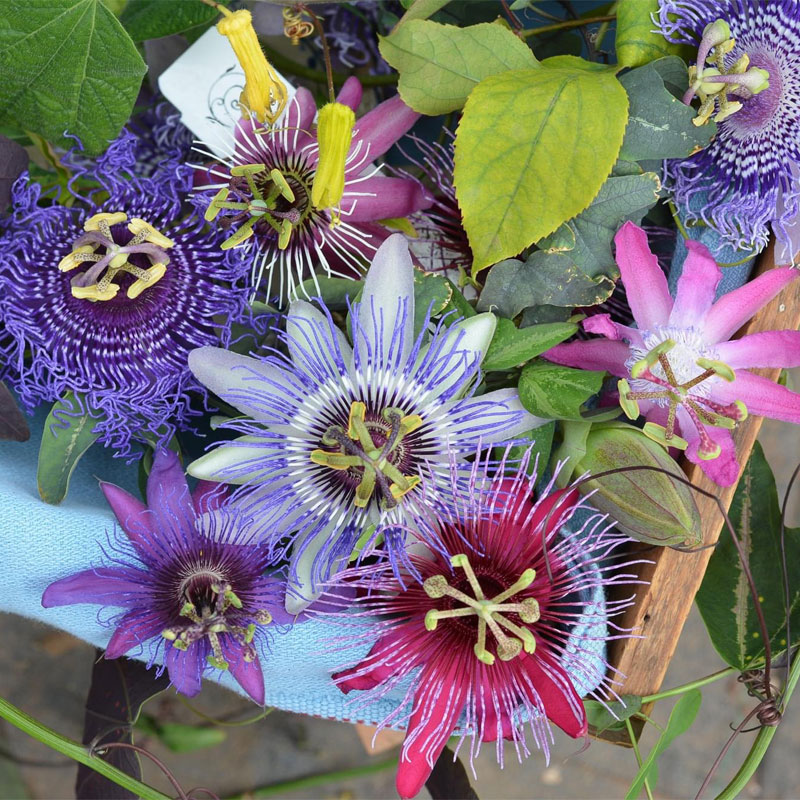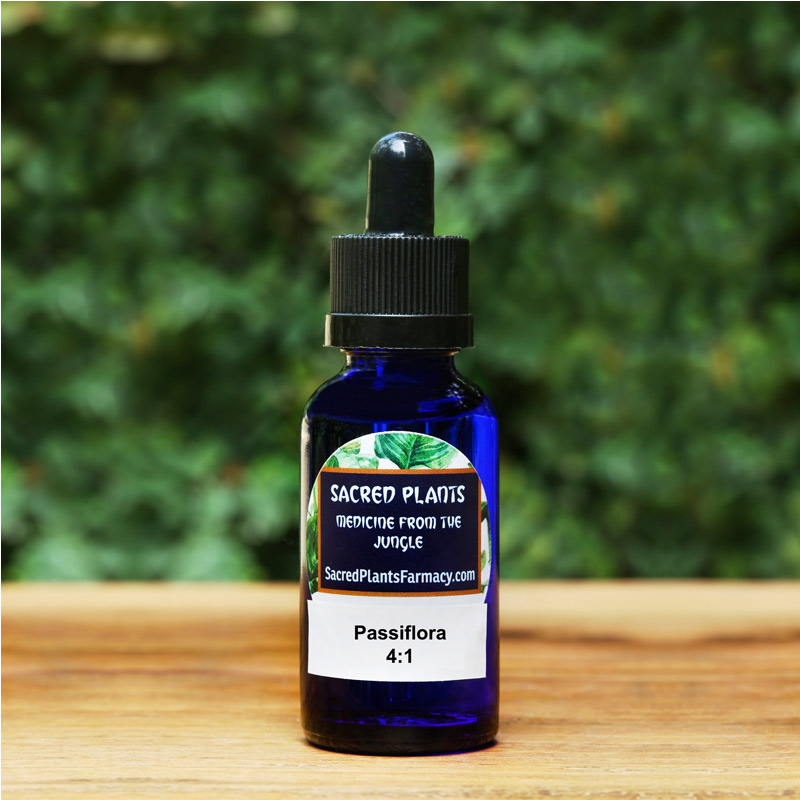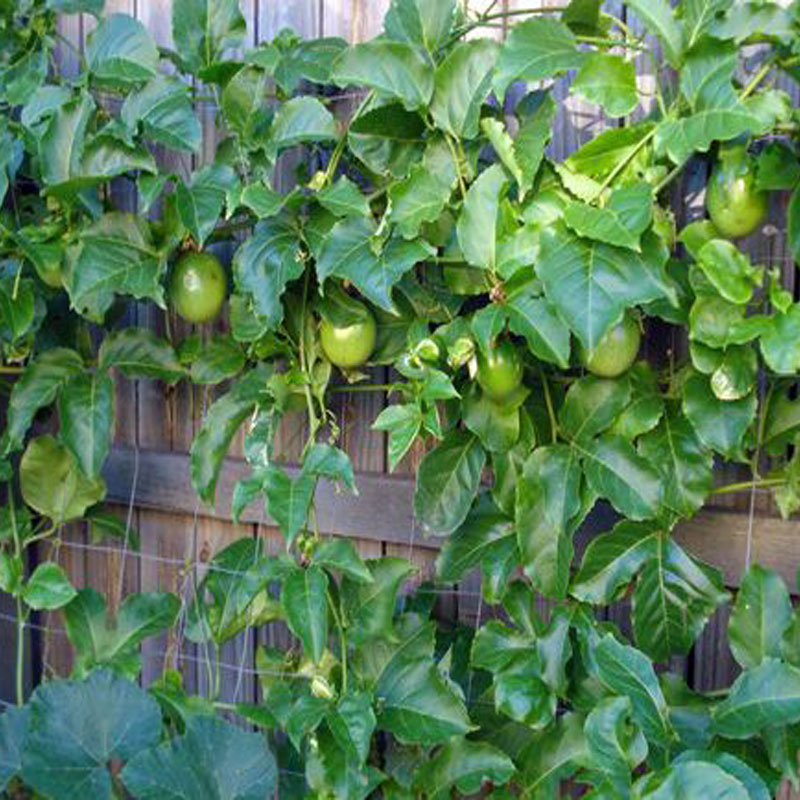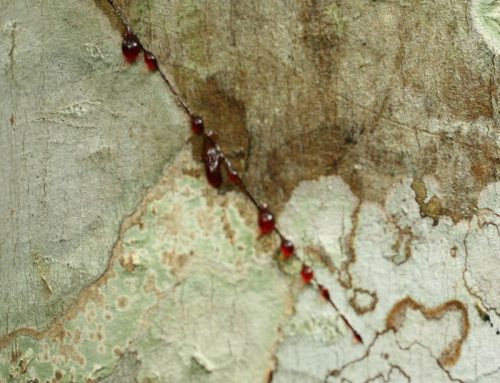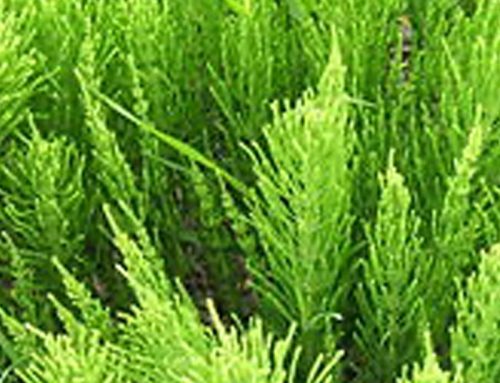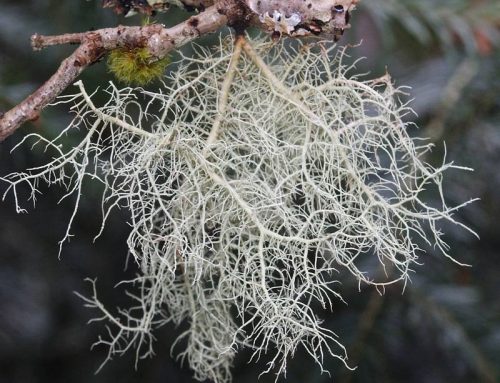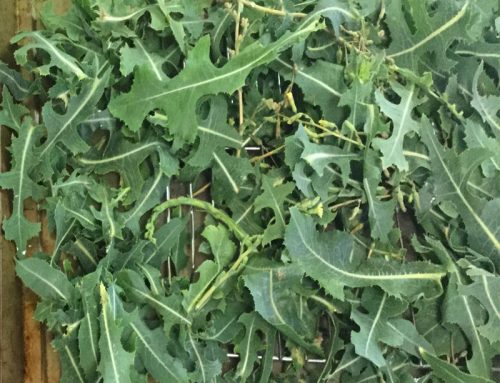- hypnotic (sleep-aid)
- analgesic (pain-reliever)
- hypotensive (lowers blood pressure)
- nervine
- anxiolytic (anti-anxiety)
- anti-spasmodic
- antidepressant
Common Name: Passionflower, maypop, old field apricot
Scientific name:
- Passiflora incarnata – official species. Native vine to the southeastern US, growing west to eastern Texas and Oklahoma, and north to southern Illinois, Ohio and Pennsylvania. Passionflower grows south throughout all of Florida.
Family: Passifloraceae
Cultivated/Wildcrafted: Passionflower is abundant throughout an extensive range, so it’s not under threat as a species. Although, in the peripheries of its range, it may be only sporadically found. At the time of this writing, most of the major herbal distributors in the U.S. are selling organically grown herb from Italy, which is surprising considering its abundance and ease of cultivation in the southeastern U.S.
Part used: Leaves, stem, and flowers, harvest when the leaves are green and vital
Preparation & Dosage:
Tincture: 2-4 droppers full up to three times/day or before bed.
Tea: .5 to 2 grams of herb per cup of water as an infusion up to 3 times/day or before bed.
- hypnotic (sleep-aid)
- analgesic (pain-reliever)
- hypotensive (lowers blood pressure)
- nervine
- anxiolytic (anti-anxiety)
- anti-spasmodic
- antidepressant
Energetics: slightly cooling and drying, mildly bitter
Traditional Uses: The Cherokee used the roots as a poultice to draw out inflammation in thorn wounds; tea of the root in the ear for earache; and tea of the root to wean infants. [iv] The Houma people infused the roots as a blood tonic. ii
It is interesting to note that contemporary herbalists use primarily the leaves, stems and flowers, whereas the ethnobotanical literature cites medicinal use of the roots only. In discussing its inclusion into the Eclectic material medica, Felter and Lloyd state in King’s American Dispensatory: [v]
Passiflora was introduced into medicine in 1839 or 1840 by Dr. L. Phares, of Mississippi, who, in the New Orleans Medical Journal, records some trials of the drug made by Dr. W. B. Lindsay, of Bayou Gros Tete, La. The use of the remedy has been revived within recent years, Prof. I. J. M. Goss, M. D., of Georgia, having introduced it into Eclectic practice. Prof. Goss, who introduced it to the Eclectic profession, employed the root and its preparations. We know of physicians who prefer the tincture of the leaves, and others still, who desire the root with a few inches of the stem attached.
Indications/Usages:[vi] [vii]
Nervous system/antispasmodic: insomnia, anxiety, anxietous depression, hypersensitivity to pain, headaches, agitation, transitioning from addictions, tics, hiccoughs, overstimulation, nervine tonic in preventing outbreaks of the herpes simplex virus, stress-induced hypertension, and menstrual cramps. The mandala-like flower demonstrates the powerful signature of its use in circular thinking, especially during insomnia; passionflower is especially suited for folks who have a hard time letting things go, mulling them over incessantly in a repetitive manner.
Children: insomnia; trouble sleeping through the night; teething; colic; adjunct treatment in asthma; especially with panic around asthma attacks; whooping cough. See the notes below on calculating dosages for children.
Pregnancy: [viii] [ix] headache and pain, in general; prevention of herpes outbreak; hypertension; help with insomnia and exhaustion in postpartum depression; insomnia and anxiety. Please see the notes in the contra-indications section regarding passionflower’s safety in pregnancy.
Eclectic specific indications and uses: [v] irritation of brain and nervous system with atony; sleeplessness from overwork, worry, or from febrile excitement, and in the young and aged; neuralgic pains with debility; exhaustion from cerebral fullness, or from excitement; convulsive movements; infantile nervous irritation; nervous headache; tetanus; hysteria; oppressed breathing; cardiac palpitation from excitement or shock.
Michael Moorisms: [x] Cardiovascular excess in mesomorphs, ethenic middle-aged women; complementary with Crataegus, lowers diastolic pressure; PMS depression, PMS with insomnia; insomnia in sthenic individuals; and headache in hypertensive states with tinnitus.
Personal experience: I use passionflower, primarily in tincture form, for insomnia, especially with circular thinking. The person is lying in bed mulling over an unpleasant situation in their life or something they said that day, and they just can’t let it go. It is beneficial in both sleep onset and sleep maintenance insomnia. I often combine it with valerian and/or skullcap, and less frequently, hops.
Passionflower is one of the herbs I use commonly for dysmenorrhea (menstrual cramps), often in combination with motherwort, black cohosh, and kava kava. Many women find relief with passionflower for cranky PMS moments.
Considered safe for children, it is beneficial internally to take the edge off teething, and to help children relax when they are climbing up the walls. Many parents use it to help children who wake frequently throughout the night sleep more soundly. As one of our safer anti-anxiety herbs, it can be helpful in treating children’s acute or chronic anxiety, and also to help them deal with an acutely traumatic or stressful situation.
Passionflower is one of my favored remedies for acute musculoskeletal pain; I use it in combination with meadowsweet, black birch, and skullcap for muscle strains, sprains and joint inflammation in general.
Contra-indications/ Side effects: [x] bradycardia; hypotension; concurrent use of pharmaceutical sedatives.
According to Mills and Bone[xi], passionflower is in the following category of herbs:
Drugs that have been taken by only a limited number of pregnant women and women of childbearing age, without an increase in the frequency of malformation or other direct or indirect harmful effects on the human fetus having been observed. Studies in animals have not shown evidence of an increased occurrence of fetal damage.
In the American Herbal Products Association Botanical Safety Book[xii], Passionflower is not contra-indicated in pregnancy or lactation.
In Herbal Medicines, third edition {vi}, Barnes et al report no recorded drug/herb interactions, however a hydroalcoholic extract was reported to potentiate rhythmic rat spasms in isolated rat uterus, and based on these results, the author’s caution against using passionflower in pregnancy.
I am particularly conservative with herbal use in pregnancy, and believe that herbs should only been used when necessary and when there is a strong historical precedence. It is difficult to extrapolate from the ethnobotanical literature on passionflower’s use during pregnancy since little has been recorded on the herbs usage in general; contemporary use of the herb does not seem to match the recorded uses. That said, many contemporary herbalists and midwives recommend the herb’s use in pregnancy, and it is generally considered safe by most sources on botanical medicine safety. In addition, there are no adverse pregnancy events reported.
I also think intuition is a valuable tool in determining whether on not to use an herb in any situation (in combination with expert advice and research). Trust your body and trust your instincts if they tell you not to take an herb!
Determining dosage in children by weight:
To determine the child’s dosage by weight, you can assume that the adult dosage is for a 150-pound adult. Divide the child’s weight by 150. Take that number and multiply it by the recommended adult dosage. For example, if your child weighs 50 pounds, she will need one-third the recommended dose for a 150-pound adult. If the adult dosage is three droppers full of a tincture, she will need one third of that dose, which is one dropper full (1/3 of 3 droppers full). A 25-pound child would need one-sixth the adult dose, so he would receive one half of a dropper full (1/6 of 3 droppers full).
[i] Dai, C. and Galloway, L. F. (2012), Male flowers are better fathers than hermaphroditic flowers in andromonoecious Passiflora incarnata. New Phytologist, 193: 787-796.
[ii] Austin, Daniel. Florida Ethnobotany
[iii] Strachney, Wm. (1612) 1953. The Historie of Travell into Virginia Britania. London (Wright, L. B. and Freund, V., Eds. Reprinted by Hakluyt Society, London.)
[iv] Hamel, B. and Chiltoskey, Mary U. Cherokee Plants and their uses- a 400 year history
[v] Felter and Lloyd. King’s American Dispensatory
[vi] Barnes, Joanne, et al. Herbal Medicine, Third Edition
[vii] Hoffman, David. Medical Herbalism
[viii] Romm, Aviva Jill. The Natural Pregnancy Book – Herbs, Nutrition, and other Holistic Choices.
[ix] Romm, Aviva et al. Botanical Medicine for Women’s Health
[x] Moore, Michael. Southwest School of Botanical Medicine, 2001. Author’s personal class notes
[xi] Mills, S. and Bone, K. The Essential guide to Herbal Safety
[xii] McGuffin, Michael et al. American Herbal Products Association’s Botanical Safety Handbook
